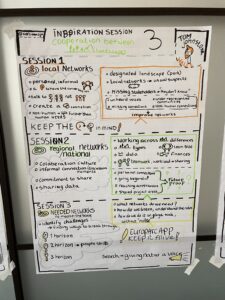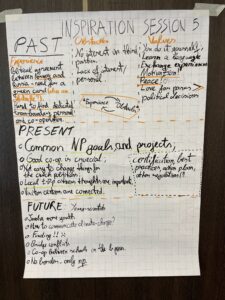EUROPARC Conference 2023. Picture by PDF-Grafie.
The Inspiration Sessions were the place to exchange and discuss with experts on a topic of choice. There were 12 topics to choose from. Members from the Youth Core Team captured the outputs in posters. Please note that Inspirations Sessions 6, 7 and 11 were cancelled.
1. Dark sky parks Hortobágy National Park, Hungary

Outcomes poster on Dark Sky Parks. Click to enlarge.
Led by István Gyarmathy (National Park Directorate)
The Hortobágy National Park in Hungary is an official ‘Dark Sky Park’, as one of 300 worldwide members of dark sky places network, approved by the International Dark Sky Association. During this session, the coordinator István Gyarmathy introduced the concept of dark sky places and gave Delegates an insight into his long standing experience with the Hortobágy National Park’s efforts protecting the natural nighttime environment.
2. Natural climate buffers: Peat meadow areas, Netherlands
Led by Vera Geelen (Staatsbosbeheer) and Frank Hoffman (Natuurmonumenten)

Outcomes poster on Natural Climate Buffers. Click to enlarge
Peat meadows and peatlands form important natural climate buffers; they limit the impact of climate change, also in National Parks. At the same time, they form regions of large economic activity, mainly agriculture. What role can National Parks play within these landscapes, within the Netherlands but also in the wider context of Europe?
In this session, the historical context of natural climate buffers was discussed; how have we formed our landscape in the last century, mainly focused on large-scale food production. The specific case of peat meadows in the Netherlands served to illustrate how the ‘harmony between nature and people’ has changed over time. Vera and Frank also introduced climate buffers in other Protected Areas.
3. Cooperation between designated landscapes, Wales, United Kingdom

Outcomes poster on Cooperation between designated Landscapes. Click to enlarge.
Led by Tom Johnstone (Tirwedday Cymry/ Landscapes Wales)
In Wales a common strategic plan for Nature Recovery in the 8 Designated Landscapes (including Areas of Outstanding Natural Beauty (AONB) and National Parks) is being developed. It asks the question of how we can establish nature recovery at the core of the work and culture of all these landscapes. This Inspiration Session asked the question: how can we build sustainable, functioning professional networks for collaboration, and most importantly, how can we work better together rather than in isolation?
4. Rights of nature: Initiatives worldwide
Led by Tineke Lambooy (Nyenrode Business University) and Jan van de Venis (JustLaw)

Outcomes poster on Rights of Nature. Click to enlarge.
Can a National Park have rights? This session reviewed different initiatives worldwide on rights of nature which are part of the ‘Global Alliance for the Rights of Nature’ network. Two cases were discussed specifically; the Spanish saltwater lagoon Mar Menor, the first ecosystem in Europe to be granted legal status, and the Wadden Sea area, where much effort is put now to reach a similar outcome.
In particular, the prevailing perspectives amongst participants was discussed; what chances or barriers do they see? How can rights of nature be complementary to the existing governance structures?
5. Transboundary cooperation: Pasvik-Inari Trilateral Park, Finland and Norway

Outcomes poster on Transboundary Cooperation. Click to enlarge.
Led by Riina Tervo (Parks & Wildlife Finland) and Tiia Kalske (Troms and Finnmark, Norway)
Through Transboundary Cooperation, the Pasvik-Inari Trilateral Park cherishes nature and raises awareness on biodiversity conservation and living cultural heritage. The Parks promotes sustainable development in the joint border area of Finland, Norway and Russia, as well as human health and wellbeing. This long-standing cooperation (since 1990), was the core topic of this session. What can we learn from their experience in the past and the present?
8. The world heritage – a gift from the past to the future- Wadden Sea, Denmark, Germany and the Netherlands
Led by Anja Domnick and Cristina Nazzari of the Common Wadden Sea Secretariat

Outcomes poster on Wadden Sea Trilateral Cooperation. Click to enlarge.
The trilateral Wadden Sea Cooperation is a long-standing cooperation covering 45 years of cooperation between the Dutch, German and Danish governments within the UNESCO World Heritage Wadden Sea area. What can we learn from this strong governmental cooperation? Can non-governmental stakeholders be involved more directly? And how can we organize the involvement of young adults more structurally? This Inspiration Session sought answers to these questions!
9. From Protectionist Conservation towards Meaningful Human-Wildlife Coexistence: Thailand and South Africa

Outcomes poster on Meaningful Human-Wildlife Coexistence Click to enlarge.
Led by Antoinette van de Water (Bring The Elephant Home)
During this interactive session, Delegates explored transformative approaches aimed at fostering meaningful coexistence between humanity and wildlife. They dove into how wildlife and Protected Areas can shape a more promising and equitable future for all beings. Through a One Well-being lens, Bring the Elephant home promotes a perspective that transcends boundaries, advocating for innovative conservation strategies that are socially relevant and supported, creating mutually beneficial outcomes for wildlife, biodiversity and multiple stakeholders. This session aimed to move beyond traditional protectionist conservation approaches, by inspiring a collective drive towards increasing natural landscapes and rewilding degraded land, but with human rights and well-being filters in place. We believe that this will enable local and global support for conservation, ultimately contributing to a world where humans and wildlife can coexist in harmonious ways.
10. Connecting nature cores (Natura 2000 sites) Drents-Friese border region, the Netherlands
Led by Catrien Scholten and Henk van Hooft (regional landscape & national park board)

Outcomes poster on Connecting Nature Cores. Click to enlarge.
In the Drents-Friese border region, three nature ‘cores’ have been connected since 2013. The main goal was to preserve the quality of the nature cores by developing the inter
vening landscape and to combine ecological connections with recreational connections. The region includes two National Parks. This session focussed on the recently developed landscape biography, the challenges of working with different stakeholders on different scales and the trends towards more directive national regulations.
12. Parks and Partnerships: Co-creation and mobilization as a driver for development
 Led by Marco Berenthz (NORROEN Architects)
Led by Marco Berenthz (NORROEN Architects)
Nature serves as an arena for many different, and potentially conflicting, users. Multiple interests need to be put into consideration and planned for, in the development of new initiatives and projects in Parks. What shall an area offer and to whom? How do we create a good condition for nature and people to meet in harmony? How can we go from a passive meeting to an active meeting, where guests and locals contribute to the regeneration of nature?
Co-creation and mobilization of multiple stakeholders is an essential point of departure for both long term strategic planning, as well as in the development of specific projects, that will make a park appealing for both residents, user groups, farmers and visitors. In this session, NORRØN shared cases, best practice and strategies for using co-creation and mobilization as an essential and often underutilized driver for future development of European Nature Parks.
Please contact us for the presentation.
13. Digitalization – challenges and opportunities for protected areas. Different Protected Areas, Germany
Led by Sonja Miller (Nationale Naturlandschaften, Germany)

Outcomes poster on Paths to a Digital Future. Click to enlarge.
More and more visitors plan a visit to a National Park in the digital world, long before they arrive. They are less and less receptive to signs and information centres. We have to be more present where our guests are: in the digital space. Two years of intensive work in Germany on digital visitor management have given insight on how to build useful structures such as ‘Digitize the planet’ to better inform visitors online. Can we further improve our digital visitor management throughout Europe to fully exploit the potential in the future?
14. Wilder Parks

Outcomes poster on Wilder Parks. Click to enlarge.
Led by Amy Duthie (Rewilding Europe)
Studies show that the ecological integrity of many Protected Areas in Europe could be improved; they are in need of ecological restoration. Rewilding is a cost-effective approach to restoration that creates benefits for nature, climate, and people. Rewilding Europe and EUROPARC Federation have therefore joined forces to make a significant contribution to nature recovery in Europe through a new initiative, ‘Wilder Parks’. This session gave participants the opportunity to learn more about it!